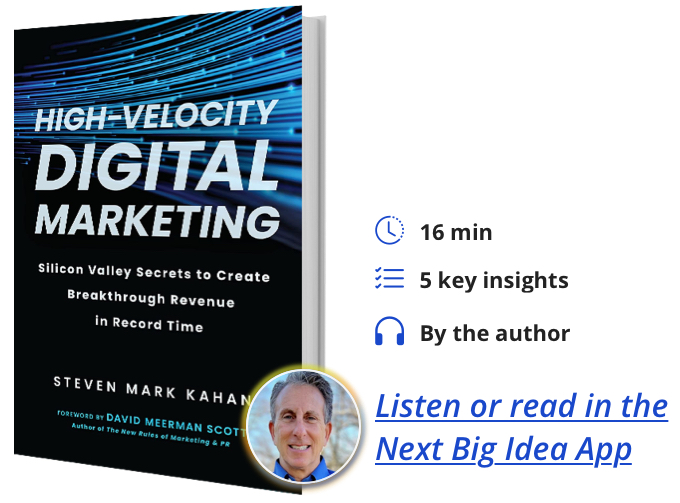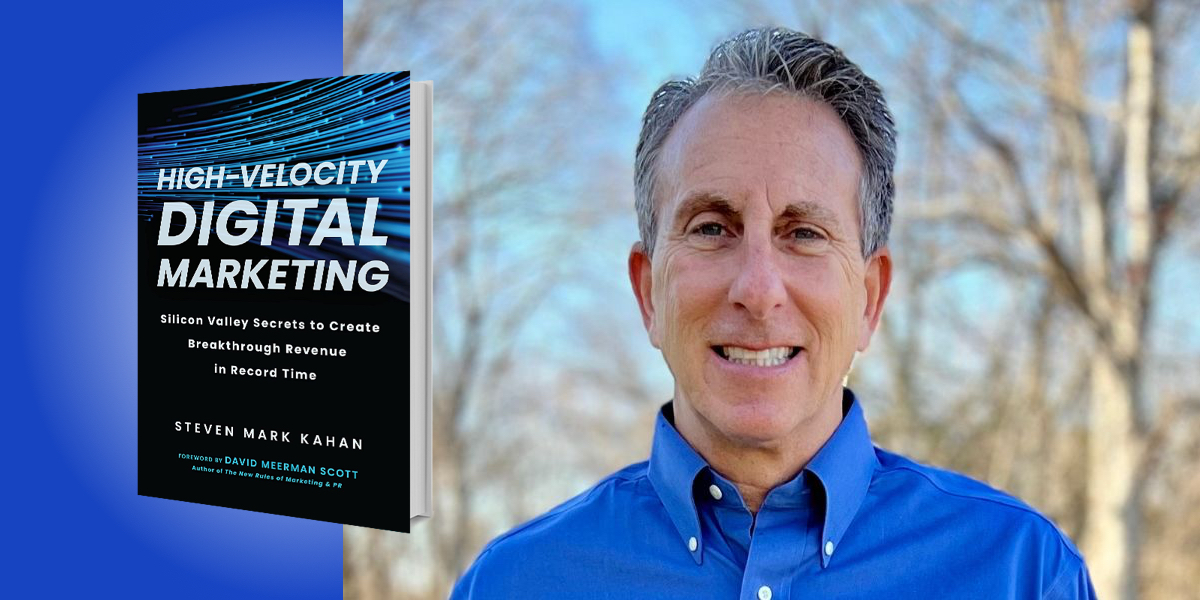Steven Mark Kahan has successfully helped grow seven startup companies from early stage to going public or being sold, resulting in $5 billion in shareholder value. He is currently a marketing advisor at Insight Partners.
Below, Steven shares 5 key insights from his new book, High-Velocity Digital Marketing: Silicon Valley Secrets to Create Breakthrough Revenue in Record Time. Listen to the audio version—read by Steven himself—in the Next Big Idea App.

1. The way people buy has totally changed.
In a recent McKinsey survey, 83 percent of CEOs said they expect marketing to drive most of their company’s growth. Yet, according to the Harvard Business Review, 80 percent of CEOs are dissatisfied with the return on their marketing investment. Many sales and marketing leaders feel overwhelmed by revenue expectations, but why is revenue growth so hard to achieve?
Because 67 percent of buyers prefer not to interact with a sales representative as their primary source of information during the buying process. Instead, buyers rely on digital content to make purchase decisions. If you are trying to buy a car, you probably aren’t looking forward to interacting with sales reps at ten different dealerships. Rather than going in person, people are more likely to run a Google search, read reviews, visit the websites of car brands, and ultimately walk away being nearly as knowledgeable about the cars of interest as the sales reps.
This new level of information parity during the buying process has totally changed how marketers must interact with potential buyers. To successfully influence customers, marketers need to engage in high-velocity digital marketing, which is all about how to use an online presence to grow revenue.
The concept behind high-velocity digital marketing is simple: The quicker you convert digital content-based leads into paying customers, the more successful your business.
2. Nail a niche.
When I ask people, Who is your ideal target buyer? I often get a vague answer or broad definition. Finding a niche often requires a company to laser focus on small segments in the market. Unfortunately, most companies avoid this for fear that a smaller customer segment will limit their growth.
It can be scary to go all in on a smaller target audience. But, trying to be all things to all people, or even to a broad segment of people, dilutes the company message and wastes money.
“Often, business is not lost to a competitor, but to the status quo.”
Nailing a niche and identifying an ideal target buyer begins with asking customers the right questions. For instance, ask them about the status quo. The status quo represents the current situation of how they conduct business. Often, business is not lost to a competitor, but to the status quo. When a customer says, I’m not interested because what we have is good enough, consider responding with one of the following:
- Describe your current process for X. What works? What doesn’t?
- What were your operations for X before you hired us?
- How does your team stay on top of X or avoid getting overwhelmed by Y?
- What are a few of the tools you currently use? What do you like about them? What do you not like.
Consider keeping a master document populated with specific phrases that customers commonly use to describe their situation and problems. Then reflect that language back to them in content and ads.
A major marketing fallacy is that creative descriptions of products stand out and win more customers. The truth is that buyers don’t care how clever the marketing department is. They want to be understood—speaking their language proves that your company does.
3. Create superior content across the full spectrum of the buyer’s journey.
Superior content gets online customers to interact with your company webpage, be that through filling out a form, making a purchase, or otherwise. To illustrate how to do this, let’s look at the first two of the four phases of the buyers’ journey: discover, consider, evaluate, and purchase.
In the discover phase, the buyer has a problem, but might not be able to articulate it. Have educational content available on your site that demystifies the problem. This content connects marketers with buyers who want to learn and allows marketers to create the playing field that competitors operate on.
“All this content fed blogs, webinars, and social media—which created leads and visibility.”
The next stage is consider. This is when buyers seek content that describes their challenges in more detail and provides options for solving them. Free tools can fulfill this phase for customers. For example, we created a free tool called The Privilege Password Risk Assessment. Buyers on our website answered a series of questions (about ten minutes worth) to evaluate their cyber security risk. Their results produced a report that gave them a grade of A through F. Since we were also collecting information about their geography, company size, and industry, we could email them an additional report describing how their results compared with their peers. This content was hugely popular and we collected so much proprietary info that we created an additional annual report on the state of the industry. All this content fed blogs, webinars, and social media—which created leads and visibility. Then, we trained our sales reps and partners on utilizing this content. For example, sales reps were trained to say things such as tell me about the grade you received or where did you score well? This changed the dynamic of our relationships because now we were perceived as a helpful partner.
To judge the quality of content, ask yourself: Is my visitor-to-lead website conversion rate more than five percent? A high website visitor to lead conversion rate indicates that the content is strong because over five percent of all website visitors willingly give their personal information—which is a sales lead. How often do you give up your personal information online? Probably not often. So, if you have greater than five percent website visitor to lead conversion rate, that content is compelling.
4. Become great on Google.
Getting found online is key to digital marketing, and today that means being found on Google. When researching a purchase, most people turn to Google first. Google accounts for 76 percent of global internet searches, making it the most popular tool by a wide margin.
To become great on Google, one tool is keywords. Keywords are what people input to search online. To attract customers through Google, companies must understand exactly what keywords customers search for and which ones enable them to rank high in the search results. The easiest way to identify these keywords is by asking the customers. There are also free tools online for understanding which words or phrases are most common. It is important that the company SEO expert collaborates with the content creator to make sure the most effective keywords are being used, and therefore your company maximizes opportunities for exposure on Google.
5. Build a high performing website.
The most important aspect of a website is whether it performs. Metrics reveal performance, and facts are the most honest guide to decision-making.
“Google accounts for 76 percent of global internet searches, making it the most popular tool by a wide margin.”
A high-performing website must contribute to revenue. It does that by (1) consistently increasing the number of people who visit and interact with the website, and (2) converting a high percentage of those visitors into revenue. Here are a few small adjustments that will greatly improve the performance of a website:
- Insert a Get a Quote button at the top of the Home Page.
- Incorporate white space to focus the viewer’s attention to the things that matter most. Think Google’s home page, which is blindingly simple. Less is often more, as unnecessary fields tend to worsen the user experience of your site.
- Offer exclusive or upgraded content.
- Implement live chat—especially on pages visitors spend the most time on.
To listen to the audio version read by author Steven Mark Kahan, download the Next Big Idea App today:































